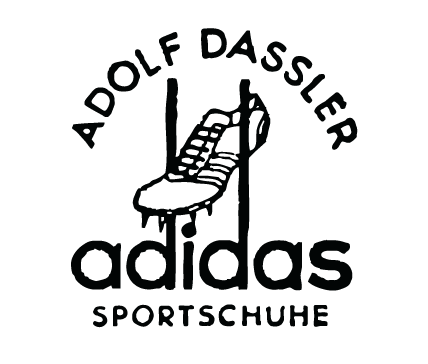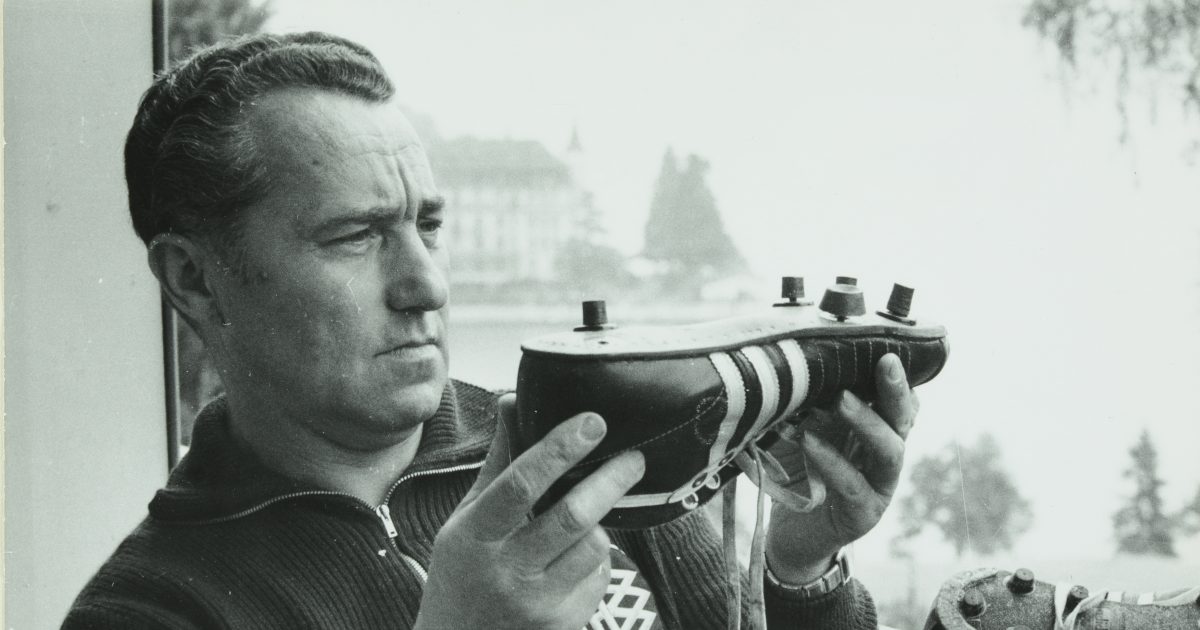
The History of Adidas
Adidas is known to be one of the world’s most popular sports manufacturers in the world, second to Nike. What is the success behind this major sports manufacturer and how did it rise the ranks over the years to be sought after and loved by many? Let’s take a look back at their humble beginnings and how Adidas became what it is today.
Founded in Herzogenaurach, Germany by a man named Adolf “Adi” Dassler(1900-1978), the company was started in his mother’s wash kitchen. Not long later, his brother Rudolf Dassler(1898-1974) joined and the company was registered in 1924 as “Gebrüder Dassler Schuhfabrik”, also known as the Dassler Brothers Shoe Factory. Adolf Dassler invented spiked shoes for track and field, which were leather shoes with nailed studs and track shoes with hand-forged spikes. He transitioned from using heavy metal spikes to utilising canvas and rubber to enhance the quality of spiked athletic footwear. As Adi was an avid athlete himself, he understood athletes and their needs when it came to footwear and wanted to provide the best for them. In the 1928 Olympic Games in Amsterdam, Lina Radke wore Adi Dassler’s shoes and won a gold medal in the 800m sprint. Adi managed to convince U.S sprinter Jesse Owens to use his handmade spikes at the Summer Olympics in 1936, where he won 4 Olympic gold medals. There were also many other athletes who donned Dassler shoes and attained medals in the Olympic games over the years. With that, Dassler shoes were made known to the world and were very popular, selling 200,000 pairs of shoes yearly before the start of World War Two.
During World War Two, the Dassler factory was used for the production of anti-tank weapons and was nearly destroyed, but thankfully Adi’s wife Käthe Martz was able to convince the US forces that the company and its employees only have intentions of manufacturing sports goods. The American occupying forces became major buyers of the Dassler brother’s shoes thereafter. Both Adolf and Rudolf were involved in the Nazi party, and Adi decided to be a coach as well as a supplier to clubs in Hitler Youth to expand production for the company. The conditions of the war proved to be difficult for both brothers to bring up their business as the country was war-torn, and the factory was constantly low on staffing. Not only that, but the relationship between the two brothers were also heavily deteriorating and a misunderstanding between the two brothers split the family into half and drove each other apart.
In 1948, the misunderstanding was proved to be irreparable and they each went on their separate ways, with Rudolf departing the company to set up his own firm which he named Ruda – derived from his name, which was later rebranded to what we know as Puma. Adi also renamed the company after the departure of his brother, naming it as Adidas, which came up by combining the first three letters of his name and surname. The two companies went into a very fierce and intense rivalry, as Puma entered the market as Adidas’ competitor. Even the two football clubs in their town were divided, with ASV Herzogenaurach club that was supported by Adidas, while 1 FC Herzogenaurach was supported by Puma. It also affected the people in the city, which led to it being nicknamed “the town of bent necks”. This was because people would see which shoes each other wore and treat them accordingly.

In 1949, Adi registered a shoe that included the now-iconic three stripes on the side. Adidas bought the rights to the three stripes trademark from a sports company called Karhu in 1952. In the same year, the first non-shoe product was introduced, a sports bag. During the 1954 World Cup final, the German national football team was faced up against the Hungarian team. The entire German team wore lightweight football boots from Adidas, and during halftime, Adi screwed longer screw-in-studs on the players’ shoes, and they eventually won the match. This was known as the “miracle of Bern” and propelled Adidas to an even higher popularity status. The first track and field warmup suit donning the iconic three stripes was produced and released in 1967. Known as the Franz Beckenbauer tracksuit, this first apparel opened a new channel for Adidas, who was known for shoes. In 1970, Adidas produced their first official ball, the TELSTAR, for the 1970 FIFA World Cup™. It was the beginning of Adidas’ partnership with FIFA, to provide the Official Match Ball for the World Cup ever since. In 1972, when it was Munich’s turn to host the Olympic Games, Adidas debuted its new logo, the Trefoil.
The impact of Adidas to the Sports Industry
By the 1970s, Adi had over a total of 440 patents, trademarks and designs related to sports shoes and other athletic equipment. In 1978, he was inducted into the American Sporting Goods Industry Hall of Fame as one of the founders of the modern sporting goods industry. A couple of months later, he passed away, leaving the company to be headed by his wife Käthe. Their children were very much involved in the business, helping out with other divisions of the company. In 1984, Käthe passed away unexpectedly, which caused a shift in the company as they did not foresee this to happen. Her son Horst, assumed leadership of the company in 1985. Focusing on pushing the company towards a change of direction, he took upon a business strategy to further push Adidas through endorsements to boost Adidas’ revenue. However, in April 1987 Horth unexpectedly passed on, which caused uncertainty for the future of the company. As Adi’s daughters had sold their shares to the company away earlier, the heirs of the company transferred management to French industrialist Bernard Tapie. He faced many issues and went into debt trying to revive Adidas’ business, and eventually, his friend Robert Louis-Dreyfus took up the post in 1994 as CEO. Together with his partner Christian Tourres, they knew that the company needed to be shifted into a new direction in order to improve and rise from the bottom. He directed Adidas to become a marketing-driven company, steering Adidas back onto the right tracks. Six years after being a corporation in 1995, Adidas went public and this brought them back to the top of the sporting industry.

Adidas continued innovating and producing shoes that could help athletes improve, with products such as Torsion, the Equipment concept and the Predator football foot. Adidas was able to acquire the Solomon group in 1997 and rebranded itself as Adidas – Salomon. In 2001, Herbert Hainer became the new CEO and led the company into the direction of innovation. Such were ClimaCool and Adizero. Adidas was the first to introduce a new lifestyle segment in their business, focusing on sports-inspired streetwear. Partnerships with individuals such as Yohji Yamamoto and Stella McCartney allowed Adidas to burst forth with creativity and introduce sportswear into mainstream daily wear. A year after Salomon and Adidas went their separate ways in 2006, Adidas acquired Reebok and the company was renamed Adidas AG.
Adidas’ mission is “To be the best sports company in the world.” and their purpose is that “Through sports, we have the power to change lives.” they believe in exercising the 3C’s throughout their organization, through Confidence, Collaboration and Creativity. They also believe in shaping their leaders to be strong and encouraging to their teams, and that a stable framework will assist them in achieving even greater, inspiring their fellow colleagues to do their utmost and serve customers with only the best products.
Currently, Adidas sells an array of items, including apparel for men and women, such as Adidas polo tees, t-shirts, jackets and many others. Adidas is the largest manufacturer of sports bras in Europe, and second in the world. They also offer sporting goods and wear for sports like football, baseball, golf, Running, and many other sports. They also offer accessories such as bags, caps, socks and many other items. Adidas also expanded into supplying printing businesses to allow customisation of Adidas items. Such for example would be drawstring bags, Adidas running tees and many other items.
Over the course of many decades, Adidas has certainly proved themselves to be of top quality, staying true to their beliefs that were envisioned by their founder, Adolf Dessler to only provide the best that can aid athletes. Even in mainstream media and culture, the brand has played a big role in shaping many things, particularly in the industry of sportswear, encouraging innovation and creativity to push quality, functional items on the shelves.
 Tasselline | Latest Articles By Singaporeans, for Singaporeans Article Site for Singaporeans
Tasselline | Latest Articles By Singaporeans, for Singaporeans Article Site for Singaporeans